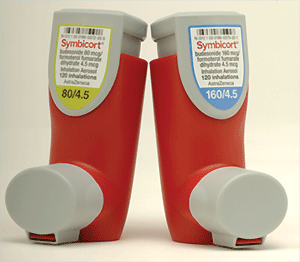Product
Symbicort 160/4.5
Approval Date
July 21, 2006
Release Date
June 27, 2007
Company
AstraZeneca
Class
Antiasthmatic (corticosteroid + long-acting ß2-agonist)
Indication
Long-term maintenance treatment of asthma in patients =12yrsold not adequately controlled on other asthma-controller medications (eg,low-medium dose inhaled corticosteroids) or those whose disease severityclearly warrants starting treatment with two maintenance therapies.
Active Ingredient
Budesonide 160mcg, formoterol fumarate dihydrate 4.5mcg; perinh; pressurized metered-dose inhaler.
Agency Roster
Medicus NY (professional)
Integrated Communications (medical education)
Cadient (interactive)
Avenue A/Razorfish (interactive)
MarketingStrategy/Execution
Symbicort’s June introduction was a year in the making, withthe lag time needed to ramp up production of drug and device. The US launch presentswelcome news for AstraZeneca, whose asthma franchise has suffered the continuedgeneric erosion of Pulmicort in other countries but in no major markets yet. Promotionalefforts are expected to be extensive, as Symbicort battles for share of voicewith GlaxoSmithKline’s Advair, its $4-billion competitor. “As a company, we’rethinking about the necessary resources to support any of our brands, and ourselling model recognizes that,” said Caroline Fitzsimons, commercial brandleader and executive director for Symbicort. AZ is supporting the launch via asingle primary care sales force and specialty force calling on specialists andpediatricians—about 3,000 feet on the street. Reps are talking to healthcareprofessionals and MCOs about appropriate selection of patients for thecombination therapy: those whose asthma is severe enough to warrant therapy.Major tactics also include a website, symbicort.com, which includesdownloadable materials for patients.
The Market
| Inhaled steroid + Bronchodilator US sales ($000s) last 5 years | |
| 2006 |
$3,983,653 |
| 2005 |
$3,598,859 |
| 2004 |
$2,954,310 |
| 2003 |
$2,325,840 |
| 2002 |
$1,509,823 |
| Source: IMS Health, Oct. 2007 |
|
| Top 3 inhaled steroid + bronchodilator | ||
| Jan.-July ’07 US sales ($000s) | % sales growth over Jan.-July ‘06 | |
|
ADVAIRDISKUS (GlaxoSmithKline) |
2,452,732 |
9 |
|
ADVAIRHFA (GlaxoSmithKline) |
43,244 |
*** |
|
SYMBICORT(AstraZeneca) |
12,567 |
*** |
| Source: IMS Health, Oct. 2007 |
||
Physician Outlook
The Symbicort launch was widely anticipated by physiciansand managed care decision-makers simply because of the amount of time betweenapproval and launch (about a year). In a study conducted in May 2007 among managedcare decision-makers, Symbicort was anticipated to be a welcome addition to theasthma treatment armamentarium but was not expected to revolutionize thecategory.
—Sue Ramspacher, senior VP, category leader, respiratory,GfK Market Measures, Oct. 2007
Also in the Pipeline(according to Adis R&D Insight)
Drug: Flutiform
Manufacturer: Abbott Laboratories
Indication: Asthma
Active Ingredient: Formoterol/fluticasone propionate
Phase: III
Source: Wolters Kluwer Health, Oct. 2007
Recent MM&MCoverage
Astrazenecaslashes jobs, Euro sales and marketing posts impacted
Advairsales strategy shifting in 2007
GSKclaims victory over AstraZeneca in asthma trials
GSKshifting sales for Advair
ProductNews from the 07/25/06 news brief
Pharmacology
Symbicort combines the antiinflammatory agent, budesonide,with the long-acting selective ß2-agonist, formoterol, in a singlemetered-dose oral inhaler.
Clinical Trials
Improvements in efficacy endpoints (eg, 12-hour-averagepost-dose FEV1 at week 2, and pre-dose FEV1 over thecourse of the study) were greater with Symbicort than with budesonide orformoterol given alone. Significant improvement in FEV1 occurredwithin 15 minutes of beginning therapy with Symbicort. Improvement in asthmacontrol occurred within one day.
Adverse Reactions
Nasopharyngitis, pharyngolaryngeal pain, sinusitis,congestion, oral candidiasis, headache, upper respiratory infection, flu, backpain, GI upset; rarely: paradoxical bronchospasm, hypersensitivity reactions;severe asthma episodes; increased risk of asthma-related death.
Adults
Not adequately controlled on low-medium dose inhaledsteroids: start with 80/4.5 strength. Not adequately controlled on medium-highdose inhaled steroids: start with 160/4.5 strength. If not currently on inhaledsteroids: choose strength depending on asthma severity. If insufficientresponse after 1–2 weeks using 80/4.5 strength, may switch to 160/4.5 strength.For all: 2 inh twice daily (AM & PM). Rinse mouth after use.
Children
Not established (see literature).
Contraindications
Not for acute relief of bronchospasm. Do not initiate insignificantly or acutely deteriorating asthma.
Precautions
Reevaluate periodically. Do not exceed recommended dose. Notfor use with other long-acting ß2-agonists or for transferring fromoral steroids. Cardiovascular disease (esp. coronary insufficiency,arrhythmias, hypertension). Convulsive disorders. Hypokalemia. Severe hepaticimpairment. Hyperresponsiveness to sympathomimetics. Diabetes. Hyperthyroidism.Ketoacidosis. Immunosuppressed. Tuberculosis. Untreated infections. Ocularherpes simplex. If exposed to chickenpox or measles, consider anti-infectiveprophylactic therapies. If adrenal insufficiency exists following systemiccorticosteroid therapy, replacement with inhaled corticosteroids may exacerbatesymptoms of adrenal insufficiency (eg, lassitude). Prescribe a short-acting ß2-agonistfor acute symptoms; monitor for increased need. Monitor potassium, intraocularpressure, bone mineral density if other osteoporosis risk factors exist; andfor growth suppression in adolescents; hypercorticism and HPA axis suppression.Pregnancy (Cat.C). Labor & delivery. Nursing mothers.
Interactions
Caution with MAOIs, tricyclic antidepressants,ß-blockers, K+-depleting diuretics, long-term ketoconazole, other potent CYP3A4inhibitors









